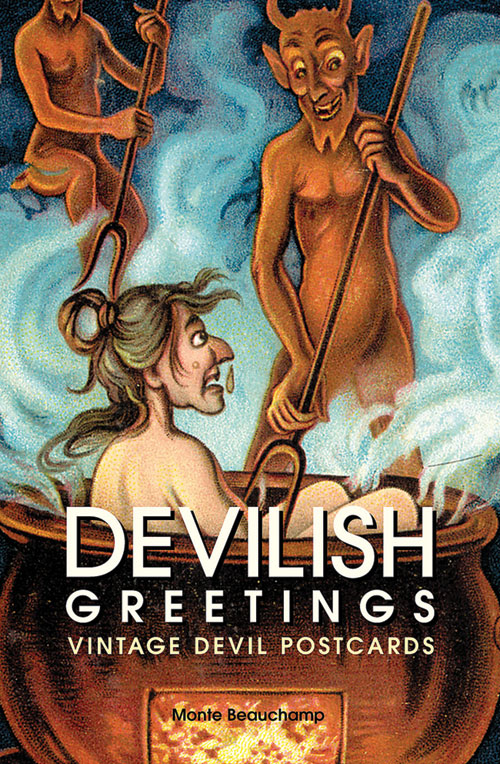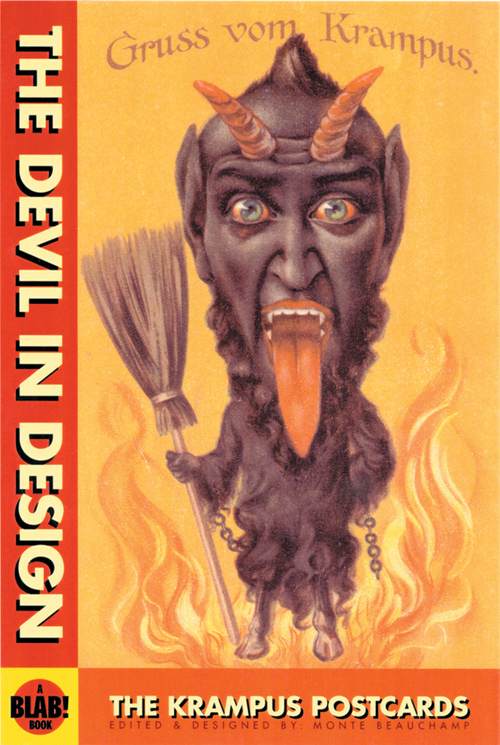

An interview with Monte Beauchamp
by Carl Macki
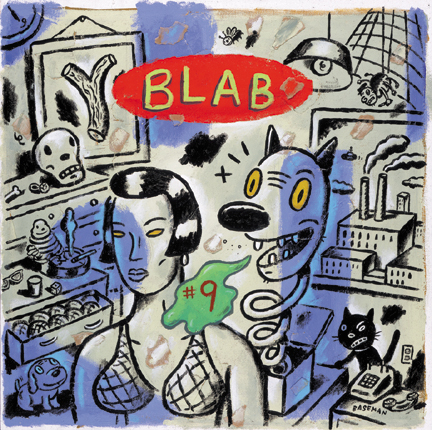 |
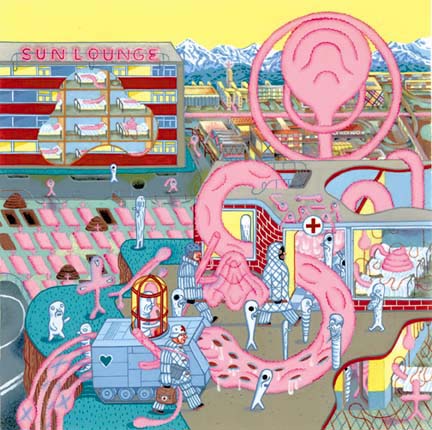 |
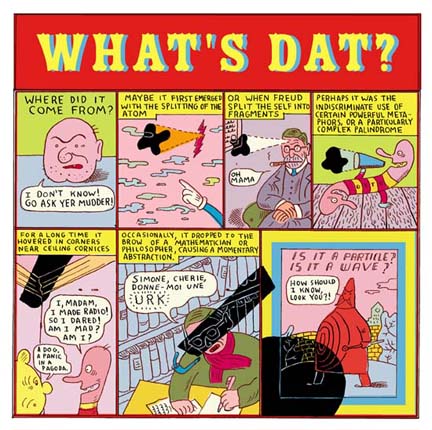 |
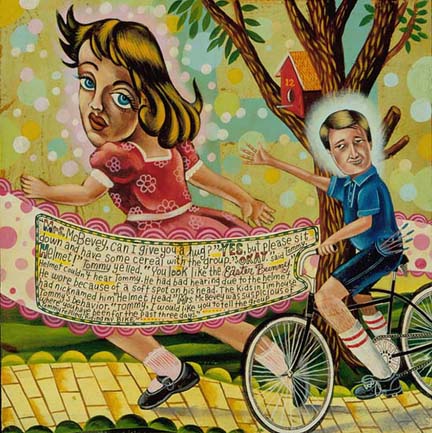 |
Bottom: Left: ©2004 Marc Rosenthal; What's Dat?; Blab! #14 Right: ©2001 The Clayton Brothers; Ding Dong! Welcome to Tim House; Blab! #12
It's
been called "the New
Yorker for Mutants." Its list of contributors
is multi-galactic in the art universe.That doesn't really do it justice. BLAB! is
more than a magazine.
It's a flourishing and nourishing fountain of
visual
ideas and creativity in illustration and design started by Monte
Beauchamp years ago, in Chicago, while Monte held down
a day job in advertising. A job that might be considered punishing.
Also one in which he has won multiple honors in New York for his art
direction.
It just keeps on getting better and stronger.
As Beauchamp tells it, " The first issue of BLAB! rolled off a long-forgotten Chicago press early summer of 1986. It was a 1500-copy, self-published, one-shot, backed financially by the money I was earning working as a full-time advertising art director. My wife at the time was actually the impetus behind it; she was the one who suggested I draw a comic book in the first place, to take my mind off the disconcerting politics and dynamics where I worked. Though I loved to draw I had no desire to draw an entire comic book, but the idea gave way to doing a 'zine about comics. So that's how the whole thing got rolling."
It just keeps on getting better and stronger.
As Beauchamp tells it, " The first issue of BLAB! rolled off a long-forgotten Chicago press early summer of 1986. It was a 1500-copy, self-published, one-shot, backed financially by the money I was earning working as a full-time advertising art director. My wife at the time was actually the impetus behind it; she was the one who suggested I draw a comic book in the first place, to take my mind off the disconcerting politics and dynamics where I worked. Though I loved to draw I had no desire to draw an entire comic book, but the idea gave way to doing a 'zine about comics. So that's how the whole thing got rolling."
Punk Globe: This was around the beginnings of the Graphic Novel--wasn't it?
MB:
BLAB! came along eight years later. In 1978, the paperback version of
Will Eisner's
A Contract with God
was the book that popularized the term "graphic novel"
and set the standard for all that has followed. The term itself was
actually coined in the sixties in an obscure comic 'zine, but never
stuck. When Eisner described A
Contract with God as a "graphic novel"
he had never heard of the term.
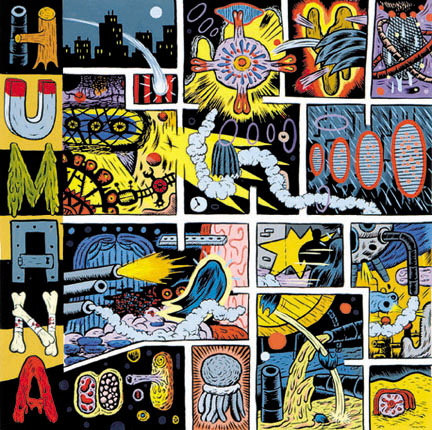 |
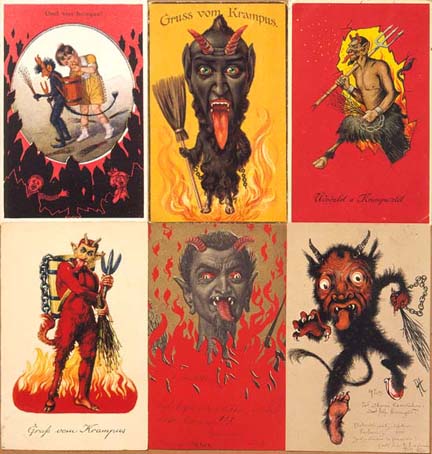 |
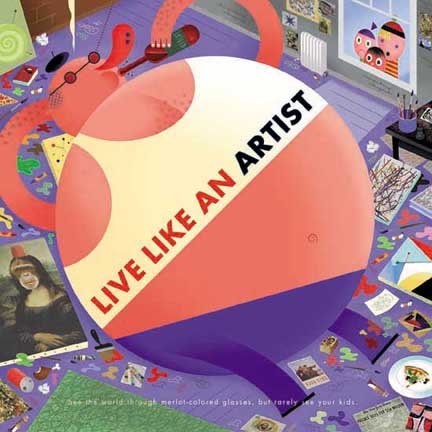 |
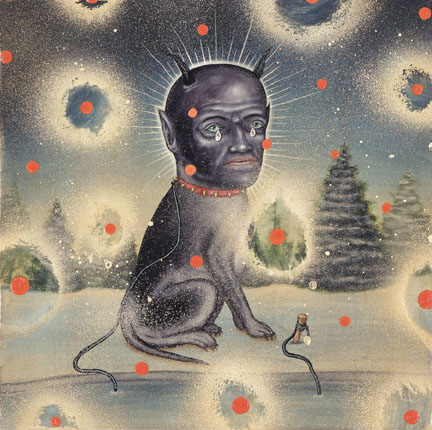 |
BOTTOM: Left: ©2005 Bob Staake; Live like an Artist; Blab! #16 Right: ©2006 Fred Stonehouse; Dog: Blab! #16
Punk Globe: Art Spiegelman (author of the Pulitzer-Prize winning MAUS) had already started Arcade with Bill Griffith (Zippy the Pinhead),
but RAW hadn't started yet, right?
MB: Arcade #1
appeared in 1975 and lasted only 2 or 3 years before Artie and
Griffith tossed in the towel, but their mag was a real enjoyable
highlight back in the day. I have real fond memories
of it. There wasn't much else out back then. Not at all like there is
today. RAW
came out in 1980. I snagged a copy but didn't think much of
it. I tore out the "Two-Fisted
Tales" insert, then tossed the rest out. The whole persona of that
first issue
had a Berlinish war-time bleakness about it. Issue #2 caught my eye
because of MAUS
and I began buying it solely for that. Yet as Raw (and
its artists) progressed, the mag became quite interesting. By issue #4
it became a must-have.
Punk
Globe: Let's
talk about your work as an art director and
your vocation as
an editor and designer
of the Blab! series of magazines and books. How much of those two worlds intersect?
of the Blab! series of magazines and books. How much of those two worlds intersect?
MB: Back in the day, I likened it to a husband with a mistress on the side. As an art director working in corporate America, BLAB! was my mistress. I was real quiet about BLAB! when it came to my professional career; I strived to keep the two things separate. Yet as the years rolled on, BLAB! took on a life of its own and I could no longer keep it under wraps. Some of my fellow employees found out about it and there were mixed reactions, though some were really positive.
I remember meeting a nice gal at one of the agencies I worked for and after we got to know each other a bit, she took me aside and asked:
"Are you, by chance, THE Monte
Beauchamp who does BLAB!???"
When I
acknowledged so, she raved about how much she adored the magazine; that
she absolutely loved it, then added, "Why in the world
are you still
working in advertising?"
When I asked what she meant by
that, she said,
"You must be wealthy from being the creator of BLAB!."
When I queried her as to why she would think that, she cited blue chip illustrators such as Gary Baseman, Jonathon Rosen, and Christian Northeast, in tandem with how well-designed and printed BLAB! was. So that was one of the good reactions. Yet, on the other hand, when a writer read the plug for my first book in Vanity Fair--The Life and Times of R. Crumb, published by St. Martin's Press--he said, "Why would you EVER do a book on Crumb?"
Punk Globe: I remember when your Krampus card reproductions came out... I think they were in BLAB! #11 -- now you have put out two books --
The Devil in Design: The Krampus Postcards and Devilish Greetings: Vintage Devil Postcards.
Can you explain how you discovered these Krampus cards?
MB: In
1990, I met a
gal at a bar whose cousin was coming by, and he turned out to be an
eclectic art aficianado. He knew about ECs, the history of Joker
playing cards... all sorts of interesting subjects.
Eight years later, the phone rings and it's this same guy checking in to say, "Hello." During the course of our conversation he waxes poetically about these pre-World War 1 Krampus postcards he's been collecting, and based on his eclectic taste, I just had to have a look. So a couple weeks later, he brings them over and my jaw goes slack. His collection of Krampus postcards was majestically incredible. So I just had to run a feature on them, which later led to my book The Devil in Design: The Krampus Postcards.
Eight years later, the phone rings and it's this same guy checking in to say, "Hello." During the course of our conversation he waxes poetically about these pre-World War 1 Krampus postcards he's been collecting, and based on his eclectic taste, I just had to have a look. So a couple weeks later, he brings them over and my jaw goes slack. His collection of Krampus postcards was majestically incredible. So I just had to run a feature on them, which later led to my book The Devil in Design: The Krampus Postcards.
Punk Globe: What is a Krampus and how does the figure relate to the Devil?
MB:
The
Krampus is of European origin and arose out of their Christmas
tradition. Krampus is St. Nicholas' helper. Whereas St. Nicholas
rewards good children with gifts and treats, the Krampus tracks down
those who have been bad all year and terrorizes them until they promise
to be good. One thing I'd like to make real clear is the Krampus is not
evil... he's not a devil... he's a character of good heart and looks
the way he does to convince the bad into becoming good.
MB: I
was going through a
bad divorce and just don't remember much from that time spent with the
Crumbs (the early '90s)... really can't comment ... my head was a big
pan of
scrambled eggs back then.
Punk
Globe: I was wondering
about BLAB!
Picto-Novelettes. Can you tell me some more about
them and what is coming down the pike with those offshoots of Blab! the magazine?
MB: They
grew out of my fondess of children's books and their beautifully
designed experimental formats with sparse copy.
I thought why not adopt it for an older crowd? I coined the term Picto-Novelette and pitched the series to Kim at Fantagraphics, who green-lighted it.
I thought why not adopt it for an older crowd? I coined the term Picto-Novelette and pitched the series to Kim at Fantagraphics, who green-lighted it.
Camille
Rose Garcia's book
was to debut the line but took way longer
than expected, so we launched with Sheep
of Fools,
by Sue Coe and Judith Brody,
which won a
Book-of-the-Year award from PETA. Next was a MAD-styled version of Struwwelpeter,
by Bob Staake, which
was plugged by NPR
and the New York Times.
Our third was Walter Minus' Darling
Cheri (see
illustration)--aimed
at the Victoria's Secret's crowd.

David Sandlin's An Alphabetical Ballad of Carnality came next and received a review in the New York Times, as did Drew Friedman's Old Jewish Comedians--which generated a phenomenal amount of press--a second-printing was ordered within a month. Camille finally delivered The Magic Bottle and it was well worth the two-year wait -- and is now in its third printing. There's one by Shag, and a followup to Drew's: More Old Jewish Comedians. Gary Baseman's is next. Ryan Heshka and I are collaborating on a BLAB!-styled superhero picto-novelette -- believe it or not. So far it's been a lot of fun. Should be out between Spring and Fall of 2010, not sure who will the publisher will be since we're no longer with Fantagraphics.

David Sandlin's An Alphabetical Ballad of Carnality came next and received a review in the New York Times, as did Drew Friedman's Old Jewish Comedians--which generated a phenomenal amount of press--a second-printing was ordered within a month. Camille finally delivered The Magic Bottle and it was well worth the two-year wait -- and is now in its third printing. There's one by Shag, and a followup to Drew's: More Old Jewish Comedians. Gary Baseman's is next. Ryan Heshka and I are collaborating on a BLAB!-styled superhero picto-novelette -- believe it or not. So far it's been a lot of fun. Should be out between Spring and Fall of 2010, not sure who will the publisher will be since we're no longer with Fantagraphics.
I asked the painters Rob and Christian the Clayton Brothers to comment on Blab! and Monte Beauchamp. Here's what they said--
"Monte Beauchamp has always given us freedom to interpret our idea of comics, even though we have never immersed ourselves in this world. We have always appreciated Monte’s insights regarding our work. He is and always will be a renegade in the wild world of comics.Long live BLAB!"
Just
about then I received an email from Monte informing me
of a new show --
earlier he had sent me the Issue of Blab!
to showcase the exhibition
in Topeka of his work at the Beach Museum there. It was good news to
learn that there will be a free, public Blab! Exhibit at
Columbia College's Leviton A+D Gallery in Chicago
June 18 through July 22. Click here
for poster of show
(PDF).
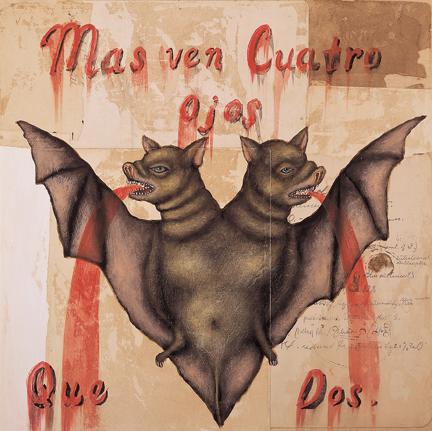 |
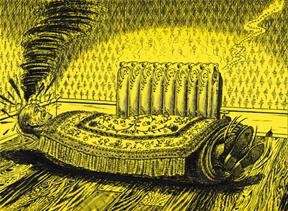 |
| Fred Stonehouse,
"Four Eyes" 12" x 12", acrylic and collage on wood panel To be published in Blab! 19 |
Don Colley, "My Burdened Heart" scratchboard drawing on laminated plastic Blab! 15 |
MIDWESTERN BLAB!
June 18 – July 22, 2009
The show, which is curated
by Chicago-based
Monte Beauchamp,
is focused on the Midwestern artists who have made powerful
contributions to BLAB!
and carry the values and standards of the publication.
Anchor Graphics at Columbia College, Chicago is the co-curator of this exhibition.
http://artseenchicago.blogspot.com/2009/05/blab-comics-anthology-gets-midwestern.html
Fred Stonehouse lecture: Wednesday, June 17 at 6:30pm, 623 S. Wabash, Room 203. No reservations needed.
back to homepage
